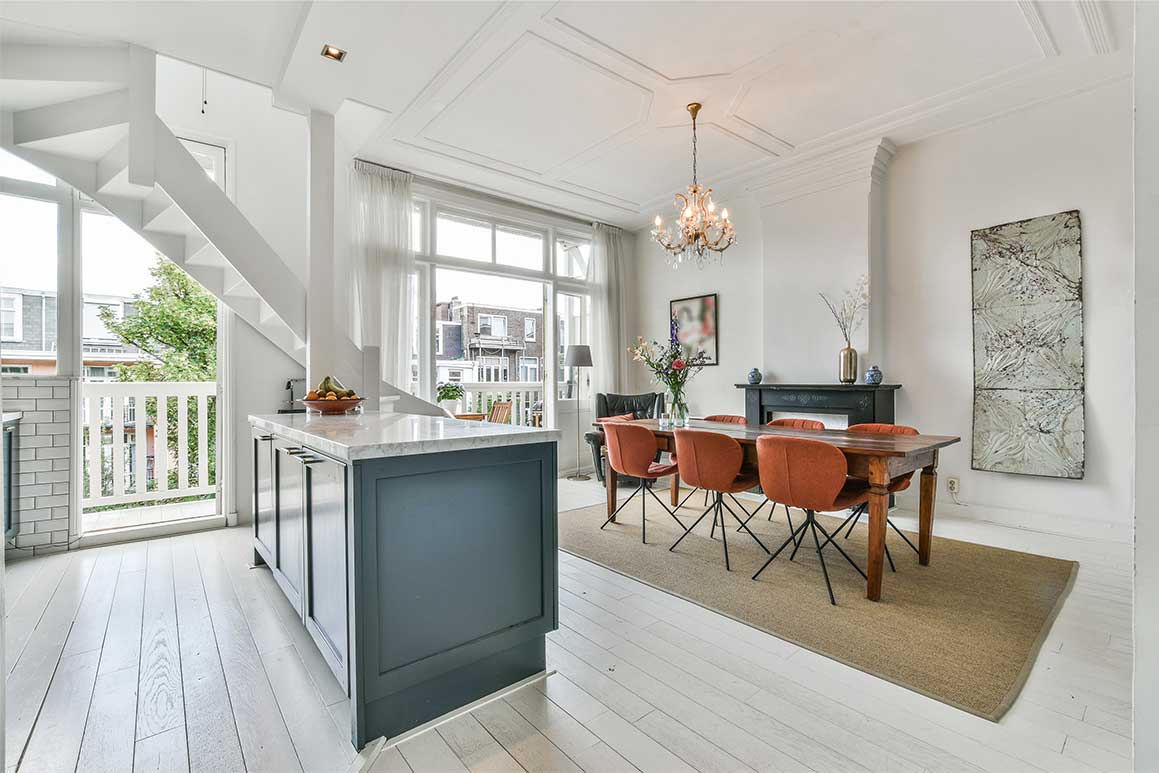 Image source
As you prepare for the transition from renting to buying, there’s plenty to be excited about. Owning your own property is exhilarating, and having just entered 2020, it’s a great time to create a resolution that you won’t want to give up.
For first-time homeowners, the process can be tricky, and you might quickly find yourself making compromises as you rush through to the finish line. And for previous homeowners, you may regret some of the hasty and uninformed decisions you made when you purchased a home for the first time.
Starting early allows you to make many of the important decisions that you struggle within a time crunch, like what neighborhood to live in or which renovations are a priority. Here’s a 2020 checklist to help you become a homeowner within one year:
Analyze Your Credit Report
The first thing you’ll want to do is get a free copy of your annual credit report and score. Your score will help you gain a better understanding of where you are right now and where you want to be. Getting your credit report a year in advance allows you to identify and fix any potential errors. Studies have found that as much as one out of four Americans have found mistakes on their credit report, and those mistakes could easily result in higher interest rates and lower credit scores. With several months ahead of you, you’re given the proper time you need to rectify any issues and have those fixes reflected in your report in the future.
Get Pre Approved
A mortgage pre-approval is one of the first and most important steps in your 2020 checklist. Getting a pre-approval puts you several steps ahead in the home buying process. Your pre-approval will give you a realistic idea of what you can afford and help you find homes that fall within your budget. Armed with a pre-approval letter, you’re also able to stay competitive amidst other potential buyers. This will help sellers understand how serious you are about making an investment.
Depending on where you’re at in your process and timeline, you might not be prepared for a pre-approval. For example, if you’ve taken a look at your credit score and credit report, you might need the proper amount of time to build up your score and fix and discrepancies. In this case, you might opt for a prequalification instead, which tells you how much you prequalify for based on an analysis of your finances. This isn’t concrete, but it can give you a solid overview of where you stand.
Create a Buying Budget
Once you have a preapproval or prequalification, you can create a buying budget to determine what your home buying costs will look like. This includes your down payment, padding for unexpected expenses, renovation costs, moving costs, closing costs, homeowner fees, and more. It helps to talk to other homeowners to get a realistic idea of what you can expect to pay as a homeowner. Many buyers are burdened with last minute financial setbacks that they were unaware of prior to purchasing a home.
Although we live in a world of instant gratification, buying a home takes time and patience. Start off by gathering all your monthly bills and listing your expenses. In addition to your utility bills, you also want to consider any mobile subscriptions, monthly entertainment fees, and other additional items that you don’t get paper bills for. Finally, go through your credit and bank cards and analyze each item line by line. Start number crunching on how much you’re currently spending on things like groceries and leisure activities.
Start Saving
A concrete savings plan makes it much easier to take the proper steps you need to achieve those savings goals. With such a big purchase on the horizon, it can be fairly intimidating, and a structured savings turns a big task into bite-sized chunks.
Create a savings goal based on your pre-approved mortgage and your expenses. Your savings goal is your down payment. You may have heard that you need 20% down payment to purchase a home. This isn’t necessarily true, although the bigger your down payment, the better interest rates you’ll get.
Your target goal depends on how much you can realistically afford to put down. Some federal governments work with mortgage companies to allow qualified candidates to own a home with as little as 3% down. For the sake of this example, let’s assume that you can place a 10% down payment (in this case, you’d need to take into account that you can expect to pay a private mortgage company until you’ve reached 20%).
For a $300,000 home and 10%, you’d need to save up $30,000. By now, you should already have funds saved up, and you can subtract your current savings from that number. Divide the remainder by 12 months, and you’ve got your monthly savings goals. Set up automatic transfers with your bank to stay on target.
Start Looking at Homes Online
Once you have a budget in mind, it’s a good time to start a preliminary search online. While not everything you find online is accurate—especially when it comes to listings and market data—an early online search will help give you a general sense of what you’re looking for and what you can realistically expect to get within your price range. Check out different platform, like Zillow and Trulia. You should also take a look at real estate agent sites, as they tend to feature neighborhood properties that stand out.
Find the Right Agent
When you’re searching for the best agent, it’s important to speak to multiple candidates. Think of this like an interview process. The person you’re hiring will guide you through one of the most important investments of your life. And when you’re working with a one-year plan, it’s crucial that you choose a no-pressure agent that isn’t pushing for a sale.
Your ideal agent will be understanding of your timeline, work within the deadlines you’ve set for yourself, and help you fine-tune your home-buying strategy. The good thing about choosing your agent far in advance is that you get to see the long-term value they bring and get plenty of opportunity to see how they work. If you aren’t happy with them, you still have enough time to find another. The right agent can also help you tap into off-the-market listings.
Image source
As you prepare for the transition from renting to buying, there’s plenty to be excited about. Owning your own property is exhilarating, and having just entered 2020, it’s a great time to create a resolution that you won’t want to give up.
For first-time homeowners, the process can be tricky, and you might quickly find yourself making compromises as you rush through to the finish line. And for previous homeowners, you may regret some of the hasty and uninformed decisions you made when you purchased a home for the first time.
Starting early allows you to make many of the important decisions that you struggle within a time crunch, like what neighborhood to live in or which renovations are a priority. Here’s a 2020 checklist to help you become a homeowner within one year:
Analyze Your Credit Report
The first thing you’ll want to do is get a free copy of your annual credit report and score. Your score will help you gain a better understanding of where you are right now and where you want to be. Getting your credit report a year in advance allows you to identify and fix any potential errors. Studies have found that as much as one out of four Americans have found mistakes on their credit report, and those mistakes could easily result in higher interest rates and lower credit scores. With several months ahead of you, you’re given the proper time you need to rectify any issues and have those fixes reflected in your report in the future.
Get Pre Approved
A mortgage pre-approval is one of the first and most important steps in your 2020 checklist. Getting a pre-approval puts you several steps ahead in the home buying process. Your pre-approval will give you a realistic idea of what you can afford and help you find homes that fall within your budget. Armed with a pre-approval letter, you’re also able to stay competitive amidst other potential buyers. This will help sellers understand how serious you are about making an investment.
Depending on where you’re at in your process and timeline, you might not be prepared for a pre-approval. For example, if you’ve taken a look at your credit score and credit report, you might need the proper amount of time to build up your score and fix and discrepancies. In this case, you might opt for a prequalification instead, which tells you how much you prequalify for based on an analysis of your finances. This isn’t concrete, but it can give you a solid overview of where you stand.
Create a Buying Budget
Once you have a preapproval or prequalification, you can create a buying budget to determine what your home buying costs will look like. This includes your down payment, padding for unexpected expenses, renovation costs, moving costs, closing costs, homeowner fees, and more. It helps to talk to other homeowners to get a realistic idea of what you can expect to pay as a homeowner. Many buyers are burdened with last minute financial setbacks that they were unaware of prior to purchasing a home.
Although we live in a world of instant gratification, buying a home takes time and patience. Start off by gathering all your monthly bills and listing your expenses. In addition to your utility bills, you also want to consider any mobile subscriptions, monthly entertainment fees, and other additional items that you don’t get paper bills for. Finally, go through your credit and bank cards and analyze each item line by line. Start number crunching on how much you’re currently spending on things like groceries and leisure activities.
Start Saving
A concrete savings plan makes it much easier to take the proper steps you need to achieve those savings goals. With such a big purchase on the horizon, it can be fairly intimidating, and a structured savings turns a big task into bite-sized chunks.
Create a savings goal based on your pre-approved mortgage and your expenses. Your savings goal is your down payment. You may have heard that you need 20% down payment to purchase a home. This isn’t necessarily true, although the bigger your down payment, the better interest rates you’ll get.
Your target goal depends on how much you can realistically afford to put down. Some federal governments work with mortgage companies to allow qualified candidates to own a home with as little as 3% down. For the sake of this example, let’s assume that you can place a 10% down payment (in this case, you’d need to take into account that you can expect to pay a private mortgage company until you’ve reached 20%).
For a $300,000 home and 10%, you’d need to save up $30,000. By now, you should already have funds saved up, and you can subtract your current savings from that number. Divide the remainder by 12 months, and you’ve got your monthly savings goals. Set up automatic transfers with your bank to stay on target.
Start Looking at Homes Online
Once you have a budget in mind, it’s a good time to start a preliminary search online. While not everything you find online is accurate—especially when it comes to listings and market data—an early online search will help give you a general sense of what you’re looking for and what you can realistically expect to get within your price range. Check out different platform, like Zillow and Trulia. You should also take a look at real estate agent sites, as they tend to feature neighborhood properties that stand out.
Find the Right Agent
When you’re searching for the best agent, it’s important to speak to multiple candidates. Think of this like an interview process. The person you’re hiring will guide you through one of the most important investments of your life. And when you’re working with a one-year plan, it’s crucial that you choose a no-pressure agent that isn’t pushing for a sale.
Your ideal agent will be understanding of your timeline, work within the deadlines you’ve set for yourself, and help you fine-tune your home-buying strategy. The good thing about choosing your agent far in advance is that you get to see the long-term value they bring and get plenty of opportunity to see how they work. If you aren’t happy with them, you still have enough time to find another. The right agent can also help you tap into off-the-market listings.

Buying Your First House in One Year: A 2020 Checklist
By Mclain Properties Tuesday, December 31, 2019
 Image source
As you prepare for the transition from renting to buying, there’s plenty to be excited about. Owning your own property is exhilarating, and having just entered 2020, it’s a great time to create a resolution that you won’t want to give up.
For first-time homeowners, the process can be tricky, and you might quickly find yourself making compromises as you rush through to the finish line. And for previous homeowners, you may regret some of the hasty and uninformed decisions you made when you purchased a home for the first time.
Starting early allows you to make many of the important decisions that you struggle within a time crunch, like what neighborhood to live in or which renovations are a priority. Here’s a 2020 checklist to help you become a homeowner within one year:
Analyze Your Credit Report
The first thing you’ll want to do is get a free copy of your annual credit report and score. Your score will help you gain a better understanding of where you are right now and where you want to be. Getting your credit report a year in advance allows you to identify and fix any potential errors. Studies have found that as much as one out of four Americans have found mistakes on their credit report, and those mistakes could easily result in higher interest rates and lower credit scores. With several months ahead of you, you’re given the proper time you need to rectify any issues and have those fixes reflected in your report in the future.
Get Pre Approved
A mortgage pre-approval is one of the first and most important steps in your 2020 checklist. Getting a pre-approval puts you several steps ahead in the home buying process. Your pre-approval will give you a realistic idea of what you can afford and help you find homes that fall within your budget. Armed with a pre-approval letter, you’re also able to stay competitive amidst other potential buyers. This will help sellers understand how serious you are about making an investment.
Depending on where you’re at in your process and timeline, you might not be prepared for a pre-approval. For example, if you’ve taken a look at your credit score and credit report, you might need the proper amount of time to build up your score and fix and discrepancies. In this case, you might opt for a prequalification instead, which tells you how much you prequalify for based on an analysis of your finances. This isn’t concrete, but it can give you a solid overview of where you stand.
Create a Buying Budget
Once you have a preapproval or prequalification, you can create a buying budget to determine what your home buying costs will look like. This includes your down payment, padding for unexpected expenses, renovation costs, moving costs, closing costs, homeowner fees, and more. It helps to talk to other homeowners to get a realistic idea of what you can expect to pay as a homeowner. Many buyers are burdened with last minute financial setbacks that they were unaware of prior to purchasing a home.
Although we live in a world of instant gratification, buying a home takes time and patience. Start off by gathering all your monthly bills and listing your expenses. In addition to your utility bills, you also want to consider any mobile subscriptions, monthly entertainment fees, and other additional items that you don’t get paper bills for. Finally, go through your credit and bank cards and analyze each item line by line. Start number crunching on how much you’re currently spending on things like groceries and leisure activities.
Start Saving
A concrete savings plan makes it much easier to take the proper steps you need to achieve those savings goals. With such a big purchase on the horizon, it can be fairly intimidating, and a structured savings turns a big task into bite-sized chunks.
Create a savings goal based on your pre-approved mortgage and your expenses. Your savings goal is your down payment. You may have heard that you need 20% down payment to purchase a home. This isn’t necessarily true, although the bigger your down payment, the better interest rates you’ll get.
Your target goal depends on how much you can realistically afford to put down. Some federal governments work with mortgage companies to allow qualified candidates to own a home with as little as 3% down. For the sake of this example, let’s assume that you can place a 10% down payment (in this case, you’d need to take into account that you can expect to pay a private mortgage company until you’ve reached 20%).
For a $300,000 home and 10%, you’d need to save up $30,000. By now, you should already have funds saved up, and you can subtract your current savings from that number. Divide the remainder by 12 months, and you’ve got your monthly savings goals. Set up automatic transfers with your bank to stay on target.
Start Looking at Homes Online
Once you have a budget in mind, it’s a good time to start a preliminary search online. While not everything you find online is accurate—especially when it comes to listings and market data—an early online search will help give you a general sense of what you’re looking for and what you can realistically expect to get within your price range. Check out different platform, like Zillow and Trulia. You should also take a look at real estate agent sites, as they tend to feature neighborhood properties that stand out.
Find the Right Agent
When you’re searching for the best agent, it’s important to speak to multiple candidates. Think of this like an interview process. The person you’re hiring will guide you through one of the most important investments of your life. And when you’re working with a one-year plan, it’s crucial that you choose a no-pressure agent that isn’t pushing for a sale.
Your ideal agent will be understanding of your timeline, work within the deadlines you’ve set for yourself, and help you fine-tune your home-buying strategy. The good thing about choosing your agent far in advance is that you get to see the long-term value they bring and get plenty of opportunity to see how they work. If you aren’t happy with them, you still have enough time to find another. The right agent can also help you tap into off-the-market listings.
Image source
As you prepare for the transition from renting to buying, there’s plenty to be excited about. Owning your own property is exhilarating, and having just entered 2020, it’s a great time to create a resolution that you won’t want to give up.
For first-time homeowners, the process can be tricky, and you might quickly find yourself making compromises as you rush through to the finish line. And for previous homeowners, you may regret some of the hasty and uninformed decisions you made when you purchased a home for the first time.
Starting early allows you to make many of the important decisions that you struggle within a time crunch, like what neighborhood to live in or which renovations are a priority. Here’s a 2020 checklist to help you become a homeowner within one year:
Analyze Your Credit Report
The first thing you’ll want to do is get a free copy of your annual credit report and score. Your score will help you gain a better understanding of where you are right now and where you want to be. Getting your credit report a year in advance allows you to identify and fix any potential errors. Studies have found that as much as one out of four Americans have found mistakes on their credit report, and those mistakes could easily result in higher interest rates and lower credit scores. With several months ahead of you, you’re given the proper time you need to rectify any issues and have those fixes reflected in your report in the future.
Get Pre Approved
A mortgage pre-approval is one of the first and most important steps in your 2020 checklist. Getting a pre-approval puts you several steps ahead in the home buying process. Your pre-approval will give you a realistic idea of what you can afford and help you find homes that fall within your budget. Armed with a pre-approval letter, you’re also able to stay competitive amidst other potential buyers. This will help sellers understand how serious you are about making an investment.
Depending on where you’re at in your process and timeline, you might not be prepared for a pre-approval. For example, if you’ve taken a look at your credit score and credit report, you might need the proper amount of time to build up your score and fix and discrepancies. In this case, you might opt for a prequalification instead, which tells you how much you prequalify for based on an analysis of your finances. This isn’t concrete, but it can give you a solid overview of where you stand.
Create a Buying Budget
Once you have a preapproval or prequalification, you can create a buying budget to determine what your home buying costs will look like. This includes your down payment, padding for unexpected expenses, renovation costs, moving costs, closing costs, homeowner fees, and more. It helps to talk to other homeowners to get a realistic idea of what you can expect to pay as a homeowner. Many buyers are burdened with last minute financial setbacks that they were unaware of prior to purchasing a home.
Although we live in a world of instant gratification, buying a home takes time and patience. Start off by gathering all your monthly bills and listing your expenses. In addition to your utility bills, you also want to consider any mobile subscriptions, monthly entertainment fees, and other additional items that you don’t get paper bills for. Finally, go through your credit and bank cards and analyze each item line by line. Start number crunching on how much you’re currently spending on things like groceries and leisure activities.
Start Saving
A concrete savings plan makes it much easier to take the proper steps you need to achieve those savings goals. With such a big purchase on the horizon, it can be fairly intimidating, and a structured savings turns a big task into bite-sized chunks.
Create a savings goal based on your pre-approved mortgage and your expenses. Your savings goal is your down payment. You may have heard that you need 20% down payment to purchase a home. This isn’t necessarily true, although the bigger your down payment, the better interest rates you’ll get.
Your target goal depends on how much you can realistically afford to put down. Some federal governments work with mortgage companies to allow qualified candidates to own a home with as little as 3% down. For the sake of this example, let’s assume that you can place a 10% down payment (in this case, you’d need to take into account that you can expect to pay a private mortgage company until you’ve reached 20%).
For a $300,000 home and 10%, you’d need to save up $30,000. By now, you should already have funds saved up, and you can subtract your current savings from that number. Divide the remainder by 12 months, and you’ve got your monthly savings goals. Set up automatic transfers with your bank to stay on target.
Start Looking at Homes Online
Once you have a budget in mind, it’s a good time to start a preliminary search online. While not everything you find online is accurate—especially when it comes to listings and market data—an early online search will help give you a general sense of what you’re looking for and what you can realistically expect to get within your price range. Check out different platform, like Zillow and Trulia. You should also take a look at real estate agent sites, as they tend to feature neighborhood properties that stand out.
Find the Right Agent
When you’re searching for the best agent, it’s important to speak to multiple candidates. Think of this like an interview process. The person you’re hiring will guide you through one of the most important investments of your life. And when you’re working with a one-year plan, it’s crucial that you choose a no-pressure agent that isn’t pushing for a sale.
Your ideal agent will be understanding of your timeline, work within the deadlines you’ve set for yourself, and help you fine-tune your home-buying strategy. The good thing about choosing your agent far in advance is that you get to see the long-term value they bring and get plenty of opportunity to see how they work. If you aren’t happy with them, you still have enough time to find another. The right agent can also help you tap into off-the-market listings.





